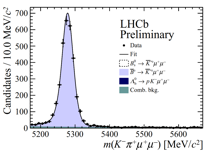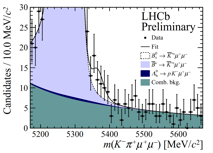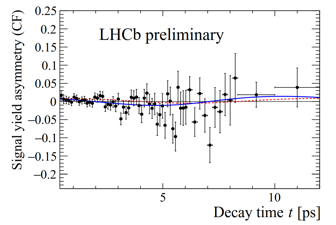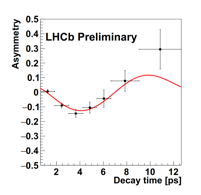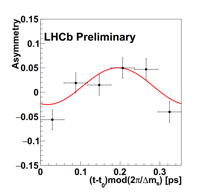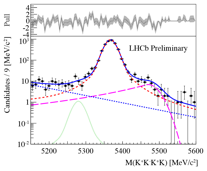The LHCb Collaboration presented new interesting results at the Rencontres de Moriond EW and at the Rencontres de Moriond QCD. A few selected items are listed below.
(1) Search for a dimuon resonance in the Υ mass region. The only known fundamental scalar particle is the Higgs boson with a mass of 125 GeV. However, additional spin-0 particles, called Φ bosons, arise in many extensions of the Standard Model (SM) and are often predicted to be lighter than the Higgs boson. The LHCb detector has good sensitivity to light spin-0 particles produced by gluon-gluon fusion and decaying to a pair of opposite-sign muons, due to its capability of triggering on objects with small transverse momentum and to its high-precision spectrometer. The results of a search for these particles produced in proton-proton collisions at center-of-mass energies of 7 and 8 TeV were presented. No evidence is found for a signal in the mass range 5.5 to 15 GeV and upper limits are placed on the product of the production cross-section and the branching fraction to pairs of muons. The limits are competitive with the most stringent ones over most of the mass region considered, and are the first limits set near the Υ resonances. The image shows the mass spectrum of the muon pair in the whole search region. Mass peaks for five hypothetical Φ-boson mass hypotheses are displayed in green.
(2) First evidence for the decay Bs0→ K*0μ+μ–. First evidence for the decay Bs0→ K*0μ+μ– with a significance of 3.4 standard deviations was presented. The left image shows the invariant mass spectrum with the dominant peaking component of the decay B0→ K*0μ+μ–, while the zoom at the right is shown to emphasise the Bs0→ K*0μ+μ– contribution. This decay is predicted to be very rare within the SM, as it occurs only through suppressed loop diagrams. New particles foreseen in extensions of the SM can significantly enhance (or suppress) the rate of this decay. The result presented at the Rencontres de Moriond paves the way to search for new physics using this decay when a larger datasets will be collected by the upgraded LHCb detector during LHC Run-3.
(3) Measurement of forward top pair production. The production of top quarks at hadron colliders represents an important test of the SM. The top quark is the heaviest known fundamental particle and its production and decay properties are sensitive to a number of parameters involved in physics models beyond the SM. The unique forward acceptance of the LHCb detector allows a phase space inaccessible to general purpose detectors such as ATLAS and CMS to be probed. Top-quark production in this region receives a higher contribution from quark-antiquark annihilation than in the central region. In addition, it probes the the proton parton distribution functions (PDFs) at high values of the fraction of proton momentum carried by quarks or gluons, whose knowledge suffers from large uncertainties. At present precise measurements of top quark production at LHCb can be used to reduce substantially the uncertainty on PDFs in this kinematic region. The large contribution from quark-initiated production also results in a larger expected charge asymmetry in the forward region than in the central region probed by ATLAS and CMS.
Top pair production was measured at the proton-proton collision energy of 13 TeV, where the production cross-section in the acceptance of the LHCb detector is expected to be ten times larger than it was at the lower Run-1 energies. The higher cross-section allows LHCb physicists to select a high-purity sample, in which the dilepton (μ and e) channel is partially reconstructed by requiring that a muon (μ), an electron (e) and a b-jet are present in the event. The image compares the measured cross-sections within the LHCb acceptance with predictions of theoretical models. Read more in CERN Courier article.
(4) Measurement of CP violation in B0→D∓π± decays. Decay-time-dependent CP asymmetries in B0→D∓π± decays have been measured for the first time at a hadron collider by analysing the decay rate as a function of the decay time of B0 mesons. The image shows an example of the measured asymmetry as a function of the decay time of the B0. The parameters describing the difference in behaviour between matter and antimatter, known as CP violation, are constrained in the so called Cabibbo-Kobayashi-Maskawa matrix unitarity triangle. The angles of this triangle are denoted α, β and γ, and among these, γ is the least precisely known, see introduction in the news of 5 October 2012. The measurement of the asymmetries presented for the first time constrain the angle γ to an interval that is consistent with the current world average. The blue line in the image is the result of this analysis, while the red, dashed line shows the expectation in the absence of CP violation. An interesting possibility is to measure precisely the angle γ in processes where new physics contributions are in principle possible and in processes where this is not allowed, looking for differences. This result belongs to the class of measurements in which the contribution of new physics is not expected.
(5) Time-dependent and time-independent CP violation in B(s)0→hh. The study of the CP violation in decays of B0 and of Bs0 mesons into two charged particles (h) that do not contain charm quarks represents a powerful tool to test the CKM picture of the SM, and also to investigate the presence of physics beyond the SM. The results of measurements of the time-dependent CP asymmetries in B0→π+π– and Bs0→K+K– decays as well as of the time-integrated CP asymmetries in B0→K+π– and Bs0→π+K– decays were presented. The results are the most precise from a single experiment and constitute the strongest evidence for time-dependent CP violation in the Bs0 meson decays to date. They also contribute to the determination of the CKM unitarity triangle. The image shows the time-dependent asymmetries for the decays (left) B0→π+π– and (right) Bs0→K+K–.
(6) Measurement of CP violation in the Bs0→φφ decay. The Bs0 decay into two φ mesons proceeds predominantly via a gluonic loop (penguin) diagram and, therefore, provides an excellent tool to search for new heavy particles which could appear within these loops, see the 14 June 2013 news for an introduction. A measurement of the time dependent CP-violating asymmetry in the Bs0→φφ decay was presented. The results obtained are consistent with the hypothesis of CP conservation. Each φ meson is observed through its decay into a K+K– meson pair. Therefore, the Bs0 meson decay is visible in the invariant mass spectrum of four K mesons, see the red dashed line contribution in the image. At lower mass values, the contribution of the B0→φφ decay (green dotted line) is not large enough to be clearly observed yet, and the most stringent limit on its branching fraction was also presented.
Read more details in the LHCb Moriond EW presentations [1], [2], [3], [5], in the Moriond QCD presentations [2], [3] and [4,5,6] as well as in the LHCb papers and conference notes [2], [3].


